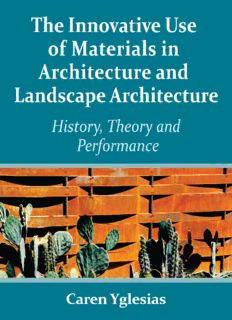
The Innovative Use of Materials in Architecture and Landscape Architecture: History, Theory and Performance PDF
Preview The Innovative Use of Materials in Architecture and Landscape Architecture: History, Theory and Performance
The Innovative Use of Materials in Architecture and Landscape Architecture This page intentionally left blank The Innovative Use of Materials in Architecture and Landscape Architecture History, Theory and Performance C Y AREN GLESIAS McFarland & Company, Inc., Publishers Jefferson, North Carolina LIBRARYOFCONGRESSCATALOGUING-IN-PUBLICATIONDATA Yglesias, Caren. The innovative use of materials in architecture and landscape architecture: history, theory and performance / Caren Yglesias. p. cm. Includes bibliographical references and index. ♾ ISBN 978-0-7864-7080-8(softcover : acid free paper) ISBN 978-1-4766-1464-9 (ebook) 1. Building materials. 2. Sustainable construction. I. Title. TA403.6.Y49 2014 691—dc23 2013051364 BRITISHLIBRARYCATALOGUINGDATAAREAVAILABLE © 2014 Caren Yglesias. All rights reserved No part of this book may be reproduced or transmitted in any form or by any means, electronic or mechanical, including photocopying or recording, or by any information storage and retrieval system, without permission in writing from the publisher. On the cover: woven steel fence at the Desert Botanical Garden (designer, Steve Martino, Landscape Architect) Manufactured in the United States of America McFarland & Company, Inc., Publishers Box 611, Jefferson, North Carolina 28640 www.mcfarlandpub.com For my wonderful sisters, Colette Silver and Cathy Ensor, women of character and kindness This page intentionally left blank Table of Contents Acknowledgments ix Preface 1 1. Concrete 5 2. Fire 22 3. Metals 34 4. Brick 49 5. Ceramics 63 6. Glass 74 Between pages 86 and 87 are 16 color photographs 7. Water 87 8. Stone 101 9. Wood 115 10. Earth 130 11. Air 143 12. Plastics 155 13. Vegetation 166 Conclusion 179 Afterword: With Measured Materials in Mind 181 Appendix: Biographies 185 Bibliography 188 Index 193 vii This page intentionally left blank Acknowledgments This book has benefited from the help of many people. Brook Hendricks, librarian at the American Society of Landscape Architects, provided assistance during the early research phase, for which I am most grateful. Several offices opened their doors and their files in sup- port of this work, for which I am most grateful. In particular, I thank Eric Blasen of Blasen Landscape Architecture, Dennis Carmichael of EDAW (now AECOM), James A. Lord and Roderick Wyllie of SurfaceDesign, Ken Smith of Ken Smith Workshop, Robert Bedell, Hallie Boyce, Daneil Mazone, Richard Roark, David Rubin (now of Land Collective), Lucinda Sanders and Jean Weston of OLIN, and Nate Trevathan of Michael Van Valkenburgh and Associates, Inc. My gratitude extends to Kory Kreiseder, who read every word of an early draft, which benefited from her keen and discriminating understanding of design. Jane Hutton, assistant professor of landscape architecture, who teaches design and materials at Harvard University’s Graduate School of Design, read a later draft and offered many helpful suggestions and insights, spurring improvement—thank you. Several scholars and practitioners took time from their busy schedules to read sections of the developing manuscript and to provide strategic comments. I am most grateful for your help: Dr. Franca Trubiano, architect and assistant professor at Penn Design, University of Pennsylvania, and author and editor of the recent book, Design and Construction of H igh- Performance Homes: Building Envelopes, Renewable Energies and Integrated Practice; landscape architect Roger Courtney, FASLA, principal at AECOM; and landscape architect Jack Sullivan, FASLA, former head of the University of Maryland’s graduate program in landscape architecture, who provided inspi- ration and support for this work as well as all of my various activities. I am also indebted to Ralph Bennett, AIA, architect and principal at Bennett Frank McCarthy Architects and professor emeritus at the University of Maryland’s school of architecture, who continues to advocate for and to teach the critical issues of sustainability—thank you for providing detailed commentary that greatly improved the clarity of my understanding of the current and future issues of design, education and sustainability. This work had the benefit of many conversations with Jason Holstine, for which I am grateful. As president of Amicus Green Building Center, the only complete showroom and supplier for exclusively green products in the Washington metropolitan area since 2005, he helps designers bring their sustainable ideals to reality. My thanks are likewise extended to the many people who helped obtain images or pro- vided them gratis,including Charles Anderson, Elizabeth Asawa, Christine Bolghand, Chris Brown, Dixi Carrillo, Jennifer Clark, Matthew Coogan, Sahar Coston- Hardy, Paul Crosby, ix
Description: